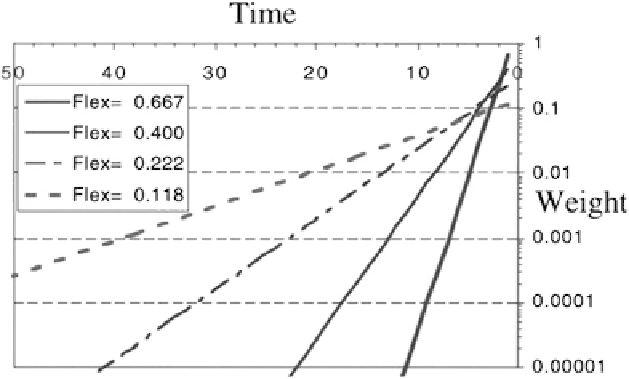Information Technology Reference
In-Depth Information
Fig. 12.3
The effectiveness of flexibility on the influence of past events on current belief
Where
α =
1 if H occurs at time t or 0 otherwise
P(H)
t
is the estimate of the probability of an occurrence of H at time t
n
is the window size
1/
n
is flexibility
The probability P(H) is calculated from the initial probability. The success or
failure of a prediction by a hypothesis for each window is used to dynamically rank
concepts. The influence on any decision is derived from the accumulated evidence.
The effect of the evidence is reduced in time (Fig.
12.3
)
The
abstraction
of features is fixed and predefined. The two sets of features are
orientated towards either determining the concept that might best fits the facts—the
set called Features type 1 (see Table
12.1
) or in providing the concepts data (e.g. the
number sequence) to generate a specific hypothesis suitable for prediction—the set
called Features type 2 (see Table 11.2 and in Chap. 11, Table
12.2
). The position of
the two sets of features in the system is shown in Fig.
12.4
It is the
first abstraction (Features type 1)
, which is
the initial abstract set of
features
we discussed earlier. The purpose of this abstraction is to identify a list of
features F1 to F4 (Table
12.2
) from a window, w
x
, provided by the controller. The
drawn feature list is used to rank concepts from which a hypothesis will be generated
to account for the sub-sequence in the current window w
x
.
The
second abstraction (Features 2)
, the drawing of the number sequence to serve
as the concept data, is done manually. The number sequence together with the ranked
concepts (see Table
12.2
) will be used by the retroductive mechanism to generate
a suitable hypothesis for the sequence. The probability of this hypothesis having
Feature 2 will then be updated to reflect past experience of a successful matching
between hypothesis and features.

